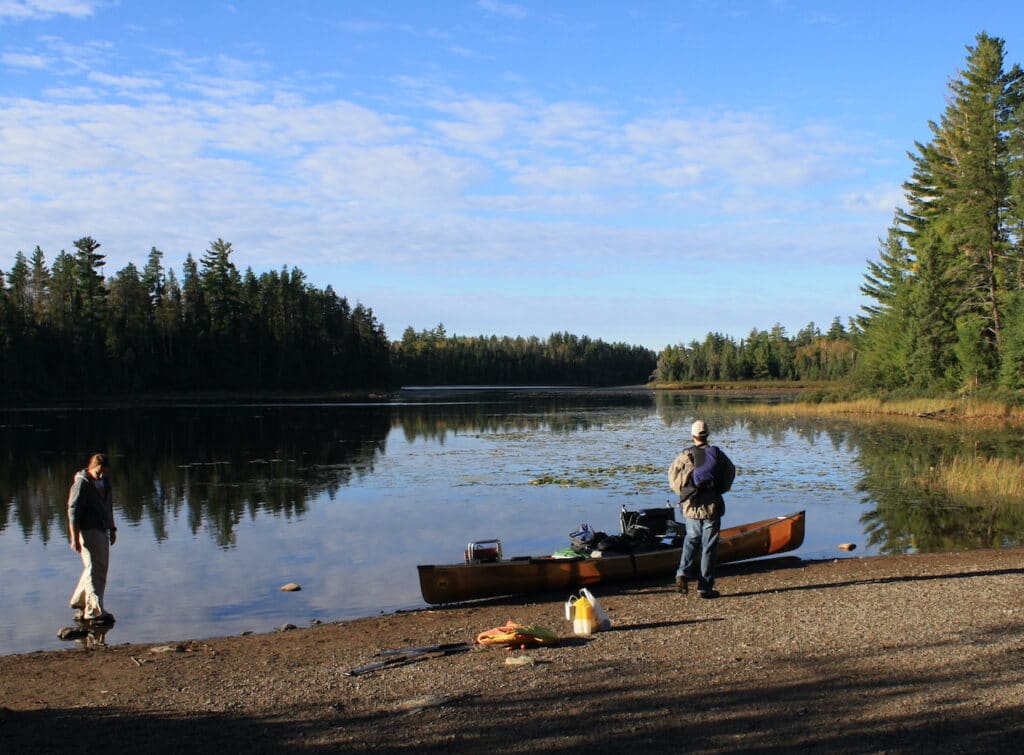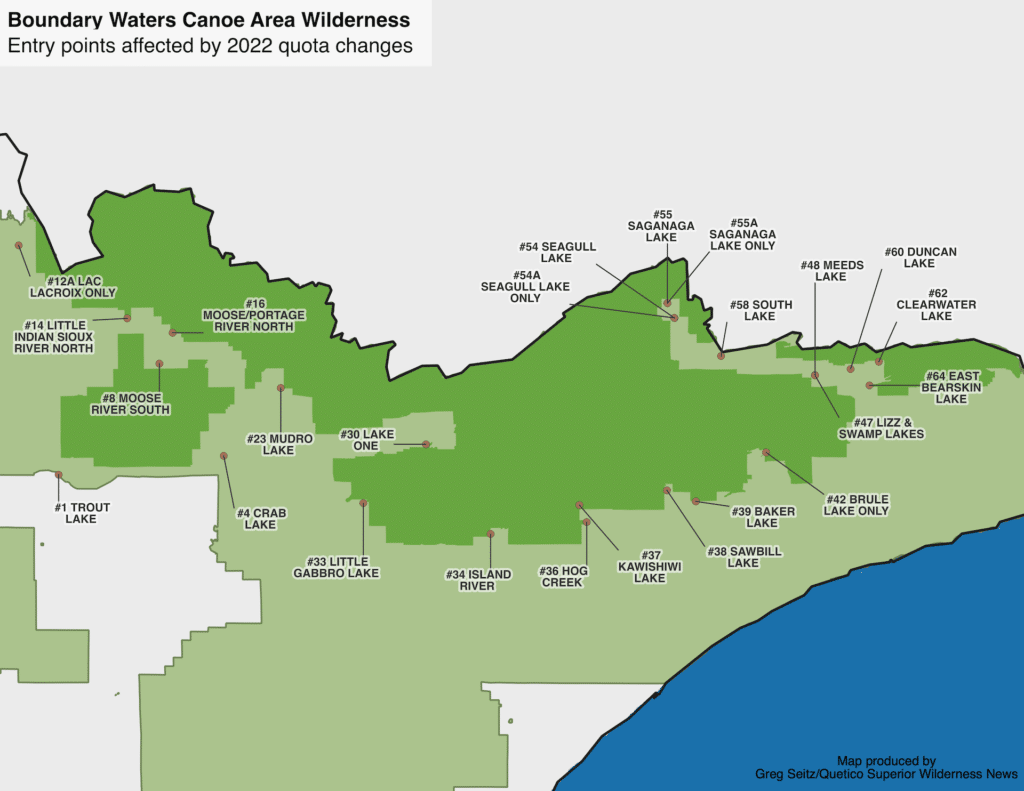
The Superior National Forest has finalized reductions in permit quotas for this year’s Boundary Waters Canoe Area Wilderness season. After intense pressure on some lakes in recent years, the Forest Service has decided to cut about 37 permits per day across 27 entry points. The 13 percent reduction in available permits could result in 5,600 fewer groups over the five-month season. The changes are in some cases complicated, with certain permit classes eliminated, but offset by additions in other classes.
Boundary Waters permits are required to enter the wilderness at a specified place and day between May 1 and September 30, applying to parties up to the maximum of nine people. The number of permits is limited each day to preserve the ecosystem and wilderness character.
For example, at the popular Lake One entry point east of Ely, seven daily permits previously available that restricted holders to camping on Lake One have been eliminated. But general Lake One entry permits have been increased by six, representing a net loss of one permit. Permits that restrict travel to the entry point lake were completely eliminated elsewhere, on Brule, Saganaga, and Seagull Lakes. Those lakes also saw reductions in their regular permit quotas.
But most of the affected entry points are simple cuts intended to reduce pressure on popular lakes and campsites. Based on average party size, the changes should reduce the number of people who visit the wilderness this year by about 23,000. In 2020, as the pandemic drove increased outdoor recreation, wilderness visitors grew by 16 percent from the previous year.
| Entry Point | Previous | New | Change |
| #1 Trout Lake | 14 | 12 | -2 |
| #12A Lac LaCroix Only | 8 | 6 | -2 |
| #14 Little Indian Sioux River North | 7 | 5 | -2 |
| #16 Moose/Portage River North | 7 | 5 | -2 |
| #23 Mudro Lake | 6 | 5 | -1 |
| #30 Lake One | 14 | 13 | -1 |
| #33 Little Gabbro Lake | 2 | 2/1 (every other day) | -1 |
| #34 Island River | 1 | 2 | 1 |
| #36 Hog Creek | 5 | 4 | -1 |
| #37 Kawishiwi Lake | 9 | 7 | -2 |
| #38 Sawbill Lake | 14 | 11 | -3 |
| #39 Baker Lake | 3 | 2 | -1 |
| #4 Crab Lake | 4 | 3 | -1 |
| #42 Brule Lake Only | 3 | 0 | -3 |
| #47 Lizz & Swamp Lakes | 4 | 3 | -1 |
| #48 Meeds Lake | 3 | 2 | -1 |
| #54 Seagull Lake | 11 | 8 | -3 |
| #54A Seagull Lake Only | 2 | 0 | -2 |
| #55 Saganaga Lake | 17 | 15 | -2 |
| #55A Saganaga Lake Only | 3 | 0 | -3 |
| #58 South Lake | 3 | 2 | -1 |
| #60 Duncan Lake | 3 | 2 | -1 |
| #62 Clearwater Lake | 3 | 2 | -1 |
| #64 East Bearskin Lake | 4 | 3 | -1 |
| #78 Brule Lake Trail | ∞ | 1 | |
| #79 Eagle Mountain Trail | ∞ | 1 | |
| #8 Moose River South | 1 | 0.5 (1 every other day) | -0.5 |
| TOTAL | -37.5 |
The quota cuts are focused on entry points where crowding has occurred, partly due to a growing trend for base camping near the entry point, rather than traveling farther into the wilderness. The intense use of a few lakes is degrading the experience and the environment.
In 2020 and 2021, wilderness visitors and managers reported resource damage and evidence of broken rules in the Boundary Waters. Living vegetation was cut, group size limits were violated, visitors camped outside designated sites, burned garbage and left waste at sites, and more.
Objections to Boundary Waters permit cuts
But some wilderness users and outfitters say the cuts were unnecessary and that problems with increased visitor numbers could be addressed through better education, enforcement about regulations and Leave No Trace principles. They also say the cuts will reduce the number of people who can enjoy the wilderness, and the valuable economic impact.
Rep. Pete Stauber, who represents the region, wrote to the Forest Service when the changes were first made public in December, calling on the agency to cancel the cuts. He said the economic impact on the area’s wilderness-based economy was not adequately considered.
“Following a record-breaking year, I am incredibly disappointed to learn that the Forest Service plans to cut permits for entry to the Boundary Waters Canoe Area, especially since they did not consult those who would be most impacted in this decision: the residents of northeast Minnesota,” Stauber said. “Many residents of Minnesota’s Eighth Congressional District have built their livelihoods around the Boundary Waters, so the Forest Service must reconsider this incredibly harmful decision.”
Stauber presented several questions to the Chief of the Forest Service, Randy Moore, in the letter. He asked about how economic factors were considered, who made the decision, alternatives considered, and other parts of the process.
The Forest Service says it is allowed to make the changes as an administrative action to amend the 2004 Forest Plan, which set out the previous permit numbers.
BWCAW permits will be available at 9 a.m. on Wednesday, Jan. 26 at Recreation.gov. People who want to visit the wilderness this summer, particularly at popular times and entry points, should reserve their permit as soon as possible.
More information:
- Notice of Administrative Changes to 2004 Forest Plan Overnight Paddle and Hiking Entry Point Quota (PDF)
- Superior National Forest announces Boundary Waters Canoe Area Wilderness permits on-sale for the 2022 quota season
- Forest Service announces 13 percent cut in Boundary Waters entry permits – MPR News


